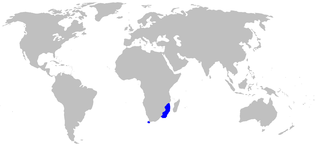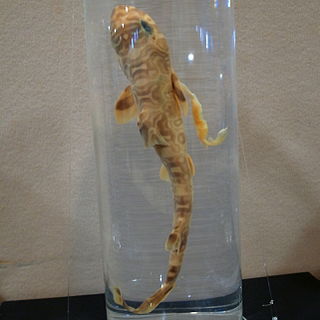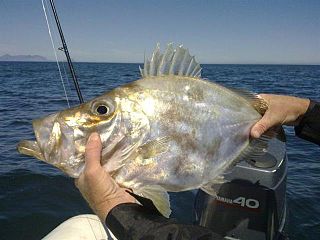
Mackerel is a common name applied to a number of different species of pelagic fish, mostly from the family Scombridae. They are found in both temperate and tropical seas, mostly living along the coast or offshore in the oceanic environment.

Herring are forage fish, mostly belonging to the family of Clupeidae.

The smallfin gulper shark is a medium-sized deepwater dogfish in the family Centrophoridae.

The poor man's tropheus is a species of fish in the family Cichlidae. Until 2007 it was the only species in the genus Neetroplus, but at that time it was reclassified into the genus Hypsophrys. In 2016 it was restored to the genus Neetroplus based on genetic research by Říčan, et al.

The Australian swellshark or draughtboard shark, is a species of catshark, and part of the family Scyliorhinidae, endemic to southern Australia. This bottom-dwelling species can be found on the continental shelf down to a depth of 220 m (720 ft). Usually measuring 1 m long, it is a stout-bodied, broad-headed shark with a short tail and a first dorsal fin much larger than the second. It can be identified by its variegated dorsal coloration of brown or grey patches and numerous spots.

The white-spotted Izak or African spotted catshark is a catshark of the family Scyliorhinidae. It is found in the western Indian Ocean off the coasts of Natal, South Africa, southern Mozambique, Madagascar, Kenya, and Tanzania between latitudes 4° S and 37° S, at depths of between 220 and 440 m. It can grow up to 35 cm in length.
The deepwater catshark is a catshark of the family Scyliorhinidae, found in the western Atlantic from Delaware Bay to Suriname, and in the eastern Atlantic from Morocco to northwest Africa. An important key factor to understanding these creatures is ageing, many deepwater Apristurus profundorum have poorly calcified vertebrae that lack visible growth bands, and most do not have dorsal fin spines that can be used for ageing. Other methods, such as captive growth and tag-recapture, are also limited in their suitability for deepwater chondrichthyans due to difficulties in the deep sea.

The Iceland or Icelandic catshark is a species of catshark, belonging to the family Scyliorhinidae. This catshark is found in the western Atlantic, from Massachusetts, Delaware, and the northern Gulf of Mexico, as well as the eastern Atlantic from Iceland, southwestern Ireland, the Canary Islands, Madeira, South Africa, and between 67 and 11°N. They are found in depths of 550 to 1450 meters near or at the bottom over upper continental slopes.

The ocellate topeshark is a species of houndshark, belonging to the family Triakidae. It is found in the western Pacific from the Ryukyu Islands to the Philippines and Taiwan.

The spotted eagle ray is a cartilaginous fish of the eagle ray family, Myliobatidae. As traditionally recognized, it is found globally in tropical regions, including the Atlantic, Pacific and Indian Oceans. Recent authorities have restricted it to the Atlantic with other populations recognized as the ocellated eagle ray and Pacific white-spotted eagle ray. Spotted eagle rays are most commonly seen alone, but occasionally swim in groups. They are ovoviviparous, the female retaining the eggs then releasing the young as miniature versions of the parent.
Taeniolethrinops laticeps is a species of cichlid endemic to Lake Malawi where it occurs over sandy substrates. This species can reach a length of 30 centimetres (12 in) TL. it was discovered by Ethelwynn Trewavas.

The whitespotted whipray or sharpnose stingray is a species of stingray in the family Dasyatidae. It is found in coastal regions including estuaries, in the Indo-Pacific, and has also been recorded in the Ganges River. It reaches a maximum length of 2 metres. As presently defined, it is probably a species complex.

An anchovy is a small, common forage fish of the family Engraulidae. Most species are found in marine waters, but several will enter brackish water, and some in South America are restricted to fresh water.

Chrysoblephus laticeps, also known as the red roman or roman seabream, is a species of sea bream from southern Africa, ranging from Namibia to the Eastern Cape. There are also old records from Madagascar and Mauritius, but the validity of these is doubtful. This demersal fish grows to a maximum length of 50 centimetres (20 in) and a recorded mass of 4.2 kilograms (9.3 lb). It is a slow-growing species showing late sexual maturity, and is closely related to the Red Stumpnose. It is found above rocky bottoms and reefs, in water up to 100 metres (330 ft) in depth and is often caught from the beach by anglers. Juveniles mature in seaweed beds and feed on mollusks, crustaceans, worms and fish. Adults are benthic feeders, living on crustaceans, sea urchins and polychaete worms.

The leerfish or garrick is a species of marine fish in the family Carangidae, and is native to the Mediterranean and the coastal waters of western Africa to the coastal waters of eastern South Africa. Also recorded in the Black Sea. These fish can reach 1.5 m in length and more than 30 kg in weight. They inhabit the coastal wave zone where they form small shoals to hunt other smaller fish, favouring mullets.

The streaked gurnard, also known as the African gurnard or rock gurnard, is a species of ray-finned fish belonging to the family Triglidae, the gurnards and sea robins. This fish is found in the eastern Atlantic Ocean and western Indian Ocean. This species is of commercial importance as a food fish.

The Cape dory, Cape Dory, or Cape John Dory is a fish of the family Zeidae. It occurs on the coast of Namibia, South Africa, and Mozambique in South Atlantic and Western Indian Oceans. It is a demersal fish that lives at the depth 35–400 m. It can reach up to 90.0 cm in total length.

the African leaffish is a species of African leaffish native to fresh waters of western Africa. Although placed in the family Nandidae by FishBase and by the 5th Edition of Fishes of the World many recent authorities place Polycentropsis in Polycentridae.
















